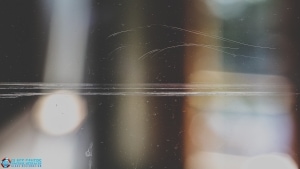Tempered glass is well known for its durability and safety features, but occasionally, you may notice scratches, small imperfections or debris on its surface. This phenomenon, known as fabrication debris, can be a frustration those who expect pristine glass. Let’s delve into what fabrication debris is, why it occurs, and how to deal with it.
What is Fabrication Debris?
Fabrication debris refers to tiny particles, spots, or imperfections that may appear on the surface of tempered glass. These imperfections are typically the result of the manufacturing process and can vary in size and appearance. Often they can’t be seen until they are dislodged and the particles scratch glass, others might appear as small specks, lines, or irregular patterns on the glass.
Why Does Fabrication Debris Occur?
- Glass Cutting and Edging: During the glass cutting and edging process, small fragments of glass may become embedded in the surface. These fragments are often difficult to detect until the glass is in use.
- Heat Treatment: The tempering process itself can sometimes cause tiny distortions or marks on the glass surface. While these are usually minor, they can be noticeable under certain lighting conditions.
- Handling and Transport: Throughout the manufacturing and transportation process, glass can encounter various contaminants, including dust, oils, or residues, which may settle on the surface.
Spotting these spots on the glass is crucial before using any aggressive cleaning method. Attempting to clean the glass, especially with a razorblade will cause scratches in the glass, at which point it’s too late for the manufacturer to replace the defective units.
Dealing with Fabrication Debris:
- Proper Cleaning: The first step in dealing with fabrication debris is proper cleaning. Use a gentle glass cleaner or a mixture of water and mild detergent to remove surface contaminants. Soft, lint-free cloths or sponges are best to avoid scratching the glass. Absolutely no razors!
- Scrutinize the Surface: Examine the glass carefully under different lighting conditions. What might seem like debris could be reflections or distortions caused by the glass’s tempering process. Ensure you’re not mistaking minor imperfections for debris.
- Contact the Manufacturer: If you believe the debris is excessive or affecting the glass’s ability to be cleaned properly, functionality or safety, it’s advisable to contact the manufacturer or supplier. They can assess the situation and provide guidance or potentially replace the glass if necessary. It’s important to spot the defects BEFORE allowing the debris to scratch the glass.
- Preventive Measures: To minimize the risk of fabrication debris, store and handle the glass carefully, keeping it protected from dust and contaminants during installation.
Fabrication debris is not present on most tempered glass but it is often enough that all tempered glass should be treated as if it does. Scratched glass can be expensive or not practical to replace. Resurfacing is the ideal solution in many cases, and choosing the right company to do this vital. The last thing you want is for an unqualified technician to make the problem worse. Glass Savers has been trusted to restore countless thousands of square feet nationwide since 2008. Based in Southern California and owner operated. Large scale and/or sensitive, specialty projects are our specialty. Many of projects completed are out of state, so no matter where you are, don’t hesitate to contact us.


